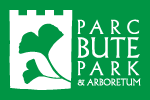Old approach road, Bute Park

![]() Old western approach road, Bute Park
Old western approach road, Bute Park
Press play for RNIB audio presentation
Or, download mp3 (1.21MB)

An extract from a 1610 map, with the old road highlighted
The main road into Cardiff from the west crossed what is now Bute Park a little to the south of where you’re standing, before a new alignment was created in 1796. The old road led to the West Gate, close to the castle. This permitted entry through the defensive stone walls built around the town in the 12th and 13th centuries.
The road is highlighted in the image on the right, an extract from John Speed’s 1610 map of Cardiff. We’ve also coloured the river Taff but as it doesn’t follow the same course today, it’s best to use Blackfriars’ Friary and West Gate as your reference points.
The West Gate was demolished in the 1780s. The bridge at the western end of the old road was prone to flood damage and replaced in 1796.
How would the old road have looked? The drawing shown here dates from before 1745. The small bridge midway along the old road crossed a stream known as the tanyard brook.

A view of Cardiff from the west, before 1745
By the 18th century, various premises clustered outside the West Gate. They included mills, a tanyard, a pub called the George Inn and a copper works. By 1787 this area was run-down. The buildings were demolished as the Bute estate acquired the land from the late 1790s to the 1840s, culminating in the enclosure of the area we now know as Bute Park. The avenue of trees ahead of you was part of the Bute family’s landscaping.
Across the grass to the north of the old road is a ring of standing stones. They may look like evidence of prehistoric rituals, but they date from 1978 – that’s AD not BC! In that year Cardiff hosted the National Eisteddfod of Wales, the principal Welsh-language festival. It takes place each August in a different part of Wales, attracting about 160,000 visitors. Bards and other high achievers, forming a group called the Gorsedd, dress in druidic robes for eisteddfod ceremonies, some of which take place at a stone circle near the eisteddfod’s site.
The Gorsedd (“throne”) was invented by an eccentric poet known as Iolo Morgannwg and has been associated with eisteddfodau since he held a Gorsedd ceremony at the Carmarthen eisteddfod in 1819.
The Gorsedd stones in Bute Park were quarried locally and have become a familiar feature, to the extent that some Cardiffians recall seeing them there long before 1978!
Thanks to RNIB for the audio presentation of this page

